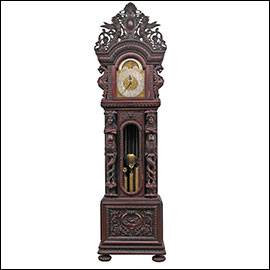Antique Grandfather Clocks
Within the field of collecting, antique grandfather clocks deserve a section of their own for their beauty and spectacularity. Their imposing presence means that today they continue to be appreciated and used in decoration, where they shine in classic style environments and stand out as exclusive pieces in eclectic and contemporary interiors. I...
Within the field of collecting, antique grandfather clocks deserve a section of their own for their beauty and spectacularity. Their imposing presence means that today they continue to be appreciated and used in decoration, where they shine in classic style environments and stand out as exclusive pieces in eclectic and contemporary interiors. In the early days, grandfather clocks were only available to the upper classes due to their high cost. In addition, their large size was only suitable for large rooms and high ceilings (some reach 2.40 meters in height). Nowadays, antique grandfather clocks are very valuable items made with fine woods and high precision mechanisms, reaching very high prices in stores and auctions.
Antique anteroom clocks are similar to grandfather clocks, but larger and with more sonorous mechanisms. Their name is due to the fact that they used to be placed in the entrance or anteroom of the houses to be able to hear the time from any space of the house. We also know these clocks as "grandfather clocks" old, a name that has its origin in the North America of the late nineteenth century.
History of antique grandfather clocks
Like that of all mechanical clocks, the history of grandfather or anteroom clocks dates back to the 17th century, when Galileo Galilei set about investigating the possibilities of pendulum motion for measuring time. His studies were put into practice by Christian Huygens, who manufactured the first known pendulum clock. Gradually the mechanism became more compact and smaller, until it gave rise to the first wall clocks. In 1658, the British Robert Hooke developed the first anchor escapement, which replaced the catalan escapement used until then. This mechanism allowed a shorter pendulum movement, which made it possible to manufacture narrower cases for wall clocks.
Hooke's discovery was seized upon by the English clockmaker William Clement, who in 1670 built the first grandfather clock on record. The clock was fitted with the royal pendulum (or pendulum seconds) mechanism created by Clement himself, with a margin of error of only 10 seconds a day. The clock was over 2.10 meters high and had glass panels on the front to show the pendulum and weights. Within a few years, Thomas Tompion (a very famous English watchmaker considered the father of British watchmaking) also began making grandfather clocks.
The name "grandfather clock" has its origins in a curious anecdote. In 1875, the American singer and songwriter Henry Clay Work made the tune "The Grandfather Clock"("The Grandfather Clock"), in which he told the story of a grandfather clock, very popular. The song's fame crossed borders and led to grandfather clocks, since then, also receiving the name Grandfather or "grandfather".
Antique grandfather clocks: materials
The antique grandfather clocks stand out for the high quality of the materials with which they are made. The cases are usually made of solid wood, usually noble species such as walnut, mahogany, cherry or even ebony. The front face has glass panels to show the dial, pendulum and weights. Many of these clocks are decorated with marquetry or inlaid details and hand-carved pieces in different styles (depending on the period and fashion). There are also models inlaid with brass or gilt bronze, and even with details decorated with gold leaf.
As imposing as they are elegant, antique grandfather clocks stand out in every space because of their designs and scale. They are pieces of enormous interest, both for collectors and for lovers of decoration and quality craftsmanship.
New products
-

Antique ivory and silver plated stethoscope, late 19th century
Antique stethoscope from the late 19th century in silver-plated metal...
-

Vintage pendant with shell cameo of Jesús del Gran Poder, carved c. 1970
Vintage pendant with a shell-carved cameo of Jesus del Gran Poder, circa...
-

Antique Roman Style Gilded Silver Chalice with Paten. France, 1932
Antique Roman-style chalice in gilded silver with paten. France, 1932....
-

Beautiful Antique 18 K Gold Ring with 7 Natural Diamonds
Antique 18K gold ring with 7 natural diamonds. Delicate openwork design,...
-

Antique Silver Reliquary. José Vilaplana. Valencia, Spain. Circa 1920
Impressive repoussé silver reliquary by José Vilaplana, Valencia, c....
-

Vintage 18K Gold Ring with 7 Natural Diamonds
Vintage 18K gold ring with seven natural diamonds in floral setting....
-

Antique Silver Chalice. Enameled Crosses. Valencia, Spain, 1942
Spanish chalice from 1942 in solid silver, gifted by the Church of...
-

Antique Silver Chalice and Paten. Granada Spain, circa 1900
Spanish chalice in white silver with matching paten, handcrafted....
Specials
-

Antique Victor II Type M Gramophone-Phonograph. USA, 1907
Awesome Victor II type M...

